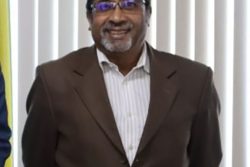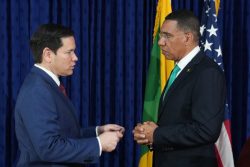Captain Gerry Gouveia yesterday denied suggestions that former army chief-of-staff Norman McLean had instructed him to take a man he later suspected to be Gregory Smith to Kwakwani and that he had gone ahead with the flight as part of a “secret mission.”
Glen Hanoman, lead counsel for the Commission of Inquiry into Dr Walter Rodney’s death, sought to make a link between McLean and Gouveia in the escape of Smith, who is the main suspect in the murder of the historian and political leader.
Gouveia was a Guyana Defence Force (GDF) pilot in June 1980, when Rodney was killed in a bomb blast. Appearing again before the commission at the Supreme Court Law Library, he was grilled for more than two hours yesterday by Hanoman, who had to be cautioned on a few occasions about his line of questioning. The previous day Gouveia was led in his evidence-in-chief by his attorney, Devindra Kissoon, following a successful application to the commission.

Gouveia, who yesterday clarified that he wasn’t subpoenaed but rather was written to and took a decision to come before the commission, had testified on the previous day that testified that he suspected he transported Gregory Smith to Kwakwani, a day after the latter allegedly engineered a bomb blast that killed Dr. Walter Rodney but he said he never saw the need to investigate. He has long been said to be the pilot who transported Smith to the Berbice River location from where he was transported to French Guiana.
During cross-examination yesterday, Gouveia spoke about the aircraft that he flew to Kwakwani on June 14, 1980 and the specific markings that were on it. According to him, no other plane had those markings.
After consulting his personal log book, he said that it showed that on June 17, he had complete control of his plane. He said that everywhere the plane went on that day, he would have been the pilot in command. He mentioned that on June 17 for the first time he flew without a co-pilot for three hours. Hanoman suggested that during those three hours he was entrusted with a secret mission and that was why he did not fly with a co-pilot for the first time that month. “You expected me to respond to you…? I rebuke that,” Gouveia said in response, triggering laughter from those sitting in the audience.
Gouveia went on to explain that he was in the cock pit alone without a co-pilot because there was no vacant seat on the plane.
On the counsel by Commission Chairman Sir Richard Cheltenham that he not respond to the suggestion, he responded “no, sir.”
According to Gouveia, he could not recall what mission he was undertaking on June 17, 1980. “But we were never on secret missions,” he said.
Turning his attention to McLean, Hanoman asked whether McLean, who once served as the human resources manager at Omai Gold Mines, contracted Gouveia to work at the company. Gouveia responded in the negative. He said that his involvement at Omai started after he left the army and he added that he was at Omai long before McLean got there.
Hanoman suggested that Omai was instrumental in the purchase of his aircrafts and that McLean was an important head figure in the management structure of that company. Gouveia denied that before explaining that the board, whose members comprised of the current president of Guyana Donald Ramotar, among others, made the decision to help provide the capital for the start of Roraima Airways. “It had nothing to do with Mr. McLean. He was in fact way down the food chain at Omai at the time,” he insisted.
PNCR attorney Basil Williams later objected to the line of questioning before inquiring whether it was “McLean bashing” and how it was relevant to the death of Dr. Rodney.
Accessory
The Chairman told Hanoman that while he wanted to give him some latitude as he had done with other lawyers, he was coming to his point “in a slow manner.”
Hanoman then suggested to Gouveia that McLean had asked him directly to take Smith to Kwakwani. However Gouveia said that he never got any instructions from McLean to fly any plane at any time directly. He said that for the record, if he had asked him, he would have flown it because he was the General of the army but he never did.
While noting that his records are accurate, Gouveia said that he never went back to Kwakwani for a very long time after the June 14, 1980 flight. He stated too that the persons at the Kwakwani airstrip would also be duty bound to have accurate records.
Gouveia told the commission that on June 17, 1980, he was at Tacama. Through his lawyer, a map showing the locations of Tacama and Kwakwani was presented and later laid over to the commission.
He stated that he did not consider the male passenger that he transported on June 14, 1980 to be a military officer or him or the other passengers accompanying him to be government officials.
“I assumed that they weren’t because they did not look that way,” he said, later adding that it was possible that they were guests or persons cleared by his superiors. He said that he had no idea whether it was a private charter or if the cost of the flight was absorbed by the GDF.
Facing further questions about the plane, he said that the plane he flew on June 14 was a nine-seater and he added that he would imagine that there would have been smaller planes owned by persons outside of the GDF that could have transported the persons he took to Kwakwani.
He said that the man, woman and children that he transported looked like Guyanese and at the time there were no anomalies to raise any suspicions.
Hanoman suggested to Gouveia that he was afraid to speak about the persons he had transported because he was afraid that he would be charged with being an accessory after the fact or even murder. Gouveia responded firmly, “no, sir.”
Moments later, Sir Richard interjected and inquired why Hanoman was going along that route. It was later stated that Hanoman should avoid such questions as the commission did not want to scare away future witnesses. It was even pointed out that according to the Terms of Reference (TOR), persons testifying will be granted pardon.
Differing records
Under questioning from Commissioner Seenath Jairam, Gouveia said the man he had transported did not operate like a soldier. “He did not look like one. He did not operate like one,” he said.
Jairam noted that witness statements tendered by Crime Chief Leslie James support the evidence he had given about the events of June 14, when he said he flew a man he suspected to Smith to Kwakwani but there a differing view about what occurred on June 17. He pointed out that a supernumerary constable, in her statement, described Gouveia’s aircraft and placed him at Kwakwani. He said that the constable said that the same aircraft that had arrived on June 14 arrived on June 17 and stopped at the landing shed.
According to Jairam, the witnesses have put his aircraft at Kwakwani on June 17.
“Why would they all say that your aircraft was back there on the 17 and you are saying otherwise, according to you log book?” he asked. Gouveia insisted that according to his log book he did not fly back to Kwakwani.
He said that if you put two Guyana Defence Force planes together you may not be able to tell them apart without looking at their registration number. It was pointed out that one of the witnesses was not present at Kwakwani on June 14 but yet he was able to record Gouveia’s
aircraft there on June 17.
Gouveia insisted that based on his log book and his recollection that he had never seen his passenger again after June 14. He said while he believed that the persons on the ground would have entered the information about a plane, it was not his. “If we could find those logs, maybe to see the entries that happened on the 14, which may have identified that particular aircraft and on the 17, if it was another GDF airplane that went there and all they did was look back at the registration to see… but I don’t know. But I had that aircraft and I did not fly to Kwakwani on that day,” he said.
He said that he was not in a position to rule out the possibility that another army plane landed at Kwakwani on June 17.








